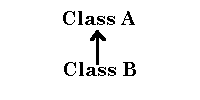
| Home : Course Map : Chapter 4 : Java : |
|
More About Constructors:
this() and super() operators |
| JavaTech |
| Course Map |
| Chapter 4 |
|
Introduction
|
| Supplements
Override/Overload Annotation-J2SE5.0 Java Security Class Loading Class Verifier SecurityManager |
| About
JavaTech Codes List Exercises Feedback References Resources Tips Topic Index Course Guide What's New |
|
In Chapter 3 we discussed the basics of constructors, including the overloading of constructors. Here we discuss some additional aspects of constructors. this() When a class holds overloaded constructors, typically they include one constructor that carries out basic initialization tasks and then each of the other constructors does additional initialization tasks. Rather than repeating code among constructors, a constructor can use the this(..) invocation to call another constructor to carry out its initialization tasks before doing the additional ones. For example, the following example shows a class with two constructors:
The first constructor explicitly initializes the values of two of the data variables (the other two will receive the default 0 value for integers). The second constructor needs to initialize the same two variables plus two more. Rather than include redundant code, the second constructor first invokes this(x,y), which executes the first constructor, and then initializes the other two variables. The argument list in the invocation of this() must match that of the desired constructor (every constructor must have a unique argument list in number and types). In this case, this(x,y) matches that of the other constructor with two int arguments. Also, the call to this() must occur in the first line of the constructor. super() For subclasses, a constructor of that class plus a constructor in each of its super-classes will be invoked (we discuss below the sequence of constructors). Similar to the this() operator, we can access particular constructors in the super-class using super(). For example, in the following code, class Test2 extends class Test1, which holds two constructors. The constructor in class Test2 invokes the first constructor in class Test1 using super(int).
As with this(), the argument list will identify which of the constructors in the super-class to invoke. Also, as with this(), the super() must lie in the first line of the constructor. Construction Sequence When you instantiate a subclass, the object will begin with an invocation of the constructor in the base class and initialize downwards through constructors in each subclass till it reaches the final subclass constructor.
The question then arises: if one or more of the super-classes have multiple constructors, which constructor does the JVM invoke? Let's begin with the simplest case of a super-class definition without any constructors other than a zero argument constructor (or the default zero argument constructor). In this case, the subclass constructor does not need to invoke super(). The JVM will automatically invoke the default zero argument constructor in the super-class. If the super-class holds one or more non-zero argument constructors and does not include a zero argument constructor, then the subclass must employ a super(...) with an argument list matching that of the desired super-class constructor. Otherwise, the compiler will give an error message since it doesn't know which super-class constructor to invoke. Note that if, in this case, the subclass also holds several constructors, each can invoke a different super() to a different super-class constructor. The compiler and JVM will figure out the proper sequence of constructors to call as it builds the instance of the subclass according to which constructor was used with the new operator. Demo 3 provides an example of a sequence of constructors invoked for the case of a base class and two subclasses, all with overloaded constructors. |
|
Tech |
|
Physics |
